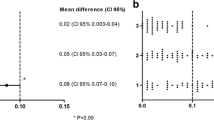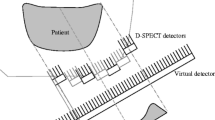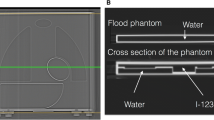Abstract.
In clinical and research studies, images obtained using carrier-added meta-[123I]iodobenzylguanidine (c.a. [123I]MIBG) have shown quite variable quality, with varying levels of uptake in lung, liver and mediastinum; this is a significant problem for quantification of the myocardial uptake by means of region ratios. First experimental and preliminary human data in respect of no-carrier-added (n.c.a.) [123I]MIBG are indicative of improved imaging quality. The aim of the present study was to evaluate the clinical value of myocardial scintigraphy with n.c.a. [123I]MIBG in patients with tachyarrhythmias. The study population comprised 24 patients with tachyarrhythmogenic diseases routinely studied by cardiac single-photon emission tomography (SPET) with [123I]MIBG. Twelve of the 24 patients were studied with c.a. [123I]MIBG (seven females and five males; mean age 42±13 years, range 20–60 years), whereas the other 12 were studied with n.c.a. [123I]MIBG (ten females, two males; mean age 41±11 years, range 18–60 years, P=NS). For quantification of the specific uptake in the different organs, count ratios were calculated on SPET images acquired 4 h p.i. Visual analysis of all [123I]MIBG scans showed improved image quality (improved contrast between heart and neighbouring organs) in n.c.a. studies as compared with c.a. studies. A significantly higher heart/left atrial blood ratio was found in the n.c.a. studies as compared with the c.a. studies (10.3±3.2 vs 5.3±1.3, P=0.0003); furthermore, significantly higher heart/lung and heart/liver ratios (2.5±0.6 vs 1.5±0.3, P=0.0002, and 0.8±0.2 vs 0.6±0.1, P=0.0006, respectively) were obtained in the c.a. studies, whereas lung/left atrial blood and liver/left atrial blood ratios showed no significant differences (4.2±1.3 vs 3.6±1.1, P=0.39, and 13.7±5.2 vs 9.6±2.2, P=0.21, respectively). In conclusion, the use of n.c.a. [123I]MIBG yields a significantly higher myocardial uptake associated with improvement in contrast between the heart and neighbouring organs and is therefore superior to the commercially available c.a. [123I]MIBG for use in clinical and research studies of the myocardial presynaptic sympathetic nervous system. Furthermore, our data indicate that for quantification the use of a left atrial blood reference region of interest, which is only available on SPET studies, is to be recommended.
Similar content being viewed by others
Author information
Authors and Affiliations
Additional information
Received 22 September and in revised form 2 November 1999
Rights and permissions
About this article
Cite this article
Knickmeier, M., Matheja, P., Wichter, T. et al. Clinical evaluation of no-carrier-added meta-[123I]iodobenzylguanidine for myocardial scintigraphy. Eur J Nucl Med 27, 302–307 (2000). https://doi.org/10.1007/s002590050037
Issue Date:
DOI: https://doi.org/10.1007/s002590050037




